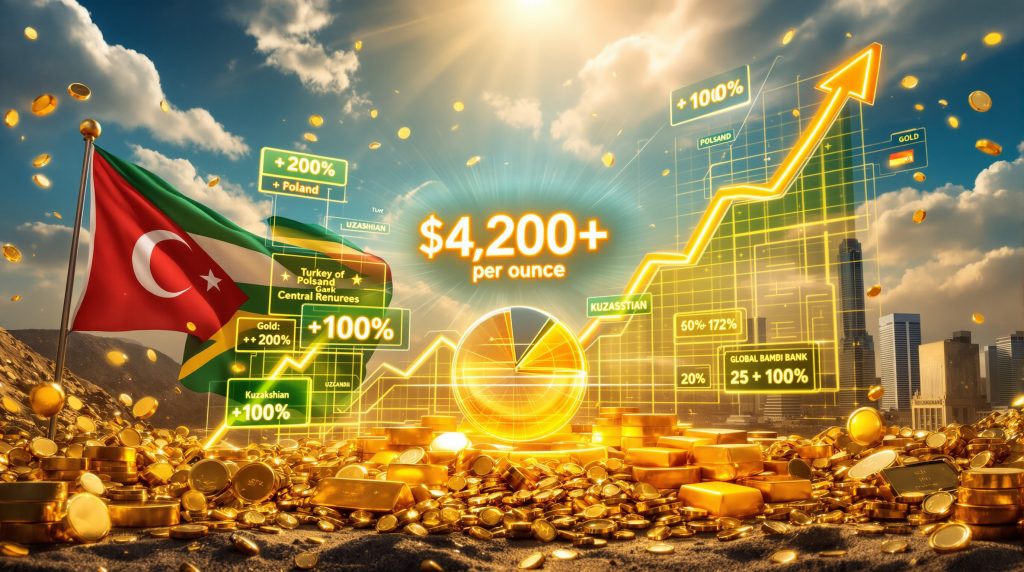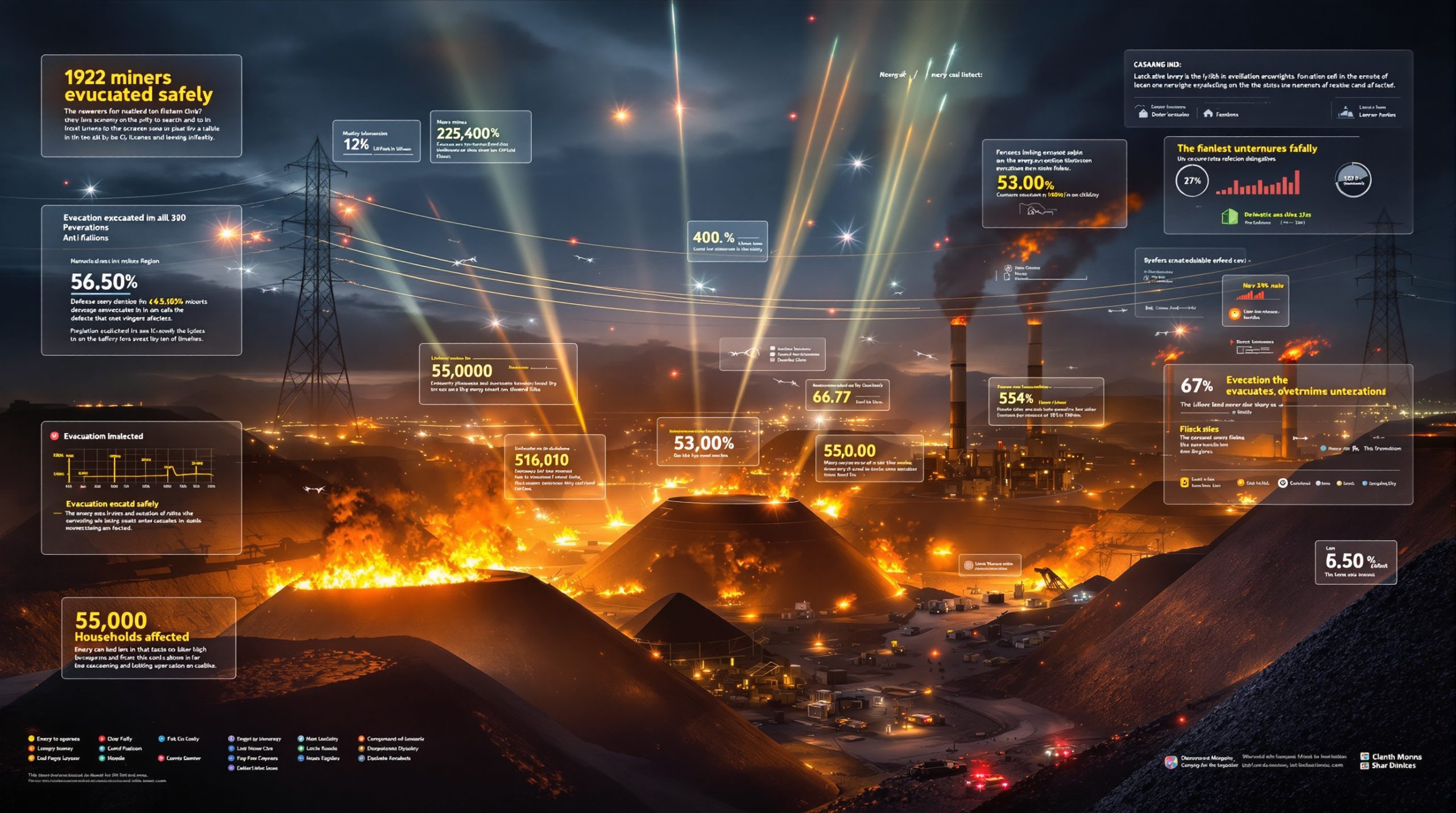The precious metals sector has reached unprecedented heights throughout 2024 and 2025, with gold futures trading above $4,200 per ounce as of October 2025. This extraordinary bull run represents more than a 100% increase from late 2023 levels, creating transformative effects across global financial markets. Emerging economies have emerged as particularly significant beneficiaries of the gold rally emerging markets phenomenon, experiencing dual advantages from both production windfalls and strategic reserve accumulation strategies.
How Are Emerging Market Producers Capitalizing on Record Gold Prices?
South African Mining Renaissance
South African gold mining companies have demonstrated remarkable market performance during this historic rally. The FTSE/JSE Africa All Shares Index surged more than 30% in 2025, positioning the country for its strongest equity performance in two decades. Major producers including Sibanye Stillwater Ltd., AngloGold Ashanti Plc, and Gold Fields Ltd. witnessed their share prices triple in value during the rally period.
The transformation extends beyond individual companies to broader market indicators. South Africa's 10-year government bond yields dropped below 9% for the first time in more than seven years, signaling dramatically improved investor confidence. The South African rand reached near one-year highs, reflecting the currency strength that often accompanies commodity booms in resource-rich economies.
This market renaissance is particularly striking given South Africa's recent economic challenges. Years of political turmoil and persistent power shortages had previously constrained economic growth and deterred international investment. The current gold market surge has provided a dramatic catalyst for renewed interest in the country's mining sector, which remains home to some of the world's deepest gold mines.
West African Gold Boom
Ghana has emerged as another standout performer in the global gold rally, leveraging its position as Africa's top gold producer to strengthen its sovereign credit profile. Following an economic crisis in 2022 that resulted in debt default, the country has demonstrated remarkable recovery under new leadership.
The Ghanaian cedi experienced approximately 38% appreciation in 2025, representing the strongest currency performance globally during this period. This currency strength, combined with improved fiscal management, contributed to Moody's credit rating upgrade for the sovereign. Furthermore, ABC's analysis highlights how the transformation illustrates the potential for gold-producing nations to leverage commodity price cycles.
Ghana's recovery trajectory demonstrates the potential for emerging markets to capitalise on favourable commodity cycles. The country's experience provides a template for how resource-rich nations can navigate from fiscal crisis to renewed market confidence through strategic management of natural resource revenues.
Which Central Banks Are Leading the Gold Accumulation Trend?
Strategic Reserve Building Patterns
Central banks in emerging markets have established themselves as the dominant force in global gold demand, pursuing systematic accumulation strategies that extend beyond traditional monetary policy considerations. Countries including Poland, Turkey, and Kazakhstan have all expanded their gold reserves significantly, while Uzbekistan maintains substantial holdings that complement its position as a major producer.
This accumulation trend reflects multiple strategic motivations beyond simple portfolio diversification. Eastern European nations face unique geopolitical considerations, while Central Asian countries benefit from proximity to major gold deposits. In addition, Middle Eastern nations view gold accumulation as a hedge against regional instability and currency volatility.
Dual Producer-Holder Advantage
Uzbekistan represents a particularly compelling case study in maximising gold exposure benefits. The country combines major bullion production capacity with substantial reserve holdings, creating what investment professionals describe as a dual benefit structure. This positioning allows the nation to profit from both mining operations and reserve appreciation during price rallies.
The strategic advantage of combining production and accumulation becomes apparent during extended price rallies. While pure consumers face increasing costs and pure producers may lack long-term price exposure, countries maintaining both capabilities can optimise their positioning across market cycles. However, our gold-stock market guide demonstrates the complexity of these relationships.
However, investment professionals caution against overemphasising the mechanical effects of gold price increases on sovereign creditworthiness. While higher gold values may appear to strengthen balance sheets, sustainable credit improvement requires broader economic fundamentals beyond commodity price movements alone.
Why Is the Dollar Weakness Benefiting Emerging Markets?
Unique Market Dynamics
The current gold rally exhibits unusual characteristics that distinguish it from historical precedents. Typically, rising gold prices coincide with broad risk-off market movements that negatively impact emerging market assets. However, the present environment combines dollar weakness with easing financial conditions, creating a fundamentally different dynamic.
This shift reflects investors' increasing interest in alternatives to traditional developed market currencies, particularly the US dollar. The gold rally emerging markets phenomenon serves as both a symptom and catalyst of this currency diversification trend, with emerging markets positioned as beneficiaries rather than casualties of the precious metals surge.
Investment Flow Reversal
Traditional market relationships suggest that gold rallies should coincide with capital flight from emerging markets toward developed market safe havens. The current cycle has inverted this pattern, with emerging markets experiencing positive flows despite heightened gold prices. Consequently, this reversal indicates a structural shift in how investors perceive risk and opportunity across global markets.
The implications extend beyond simple portfolio allocation decisions. Emerging markets that historically suffered during periods of elevated gold prices now find themselves attracting investment flows specifically because of their gold exposure. This dynamic creates self-reinforcing effects as improving market performance attracts additional capital allocation.
Macroeconomic Convergence
Several macroeconomic factors have converged to create this unusual market environment. Concerns about US economic policy direction have contributed to dollar weakness, while global financial conditions have eased from previous tightening cycles. This combination provides emerging markets with improved access to international capital while simultaneously increasing the attractiveness of gold as an alternative store of value.
The sustainability of these conditions will significantly influence the duration and magnitude of benefits flowing to gold-exposed emerging markets. Changes in Federal Reserve policy, trade relationships, or geopolitical tensions could alter the fundamental drivers supporting the current dynamic.
What Are the Investment Implications for Emerging Market Assets?
Equity Market Outperformance
Gold-exposed emerging market equities have demonstrated significant outperformance relative to broader market indices during the current rally. South Africa's market gains exceed 30% in 2025, while individual mining companies have experienced even more dramatic appreciation. This performance reflects both direct operational benefits from higher gold prices and improved investor sentiment toward resource-exposed economies.
The equity market performance extends beyond pure-play gold miners to encompass broader market indices in gold-producing nations. Furthermore, this suggests that investors are recognising the economy-wide benefits of gold price strength rather than limiting their exposure to individual mining companies alone.
Sovereign Debt Market Improvements
Bond markets in gold-rich nations have experienced yield compression and spread tightening during the rally period. South Africa's 10-year government bond yields falling below 9% represents a multi-year milestone that reflects improved credit perceptions. Similarly, Ghana's post-restructuring bonds have shown strong performance as the country's fiscal outlook brightened alongside rising gold revenues.
These improvements in sovereign debt markets create positive feedback loops for gold-producing economies. Lower borrowing costs improve fiscal flexibility, while stronger credit ratings attract additional international investment flows. The combination of operational benefits from gold production and improved financing costs amplifies the positive impact of rising precious metals prices.
Currency Strength Manifestations
Currency markets have provided some of the most dramatic evidence of gold rally benefits for emerging markets. Ghana's cedi appreciation of 38% represents the strongest global performance in 2025, while South Africa's rand has reached near one-year highs. These currency gains reflect both improved terms of trade for gold exporters and increased international investor interest in gold-exposed economies.
Currency strength creates additional benefits beyond the direct effects of gold price appreciation. Stronger currencies reduce import costs, improve inflation dynamics, and enhance the purchasing power of domestic consumers. For countries that have experienced significant currency weakness in recent years, this reversal provides meaningful economic relief.
How Sustainable Is the Current Gold Rally Trajectory?
Institutional Price Forecasts
Major financial institutions have revised their gold price forecasts substantially upward in response to the sustained rally. HSBC expects gold to reach $5,000 per ounce in 2026, having raised its 2025 average forecast to $3,455 per ounce from previous estimates of $3,355. These targets represent continued substantial appreciation from current levels near $4,200 per ounce.
The magnitude of these forecast revisions indicates that professional investors view the current rally as reflecting structural rather than purely cyclical factors. For instance, our gold all-time highs analysis shows institutional support for higher price targets provides emerging market policymakers and investors with greater confidence in planning long-term strategies around sustained gold strength.
Structural Demand Evolution
The composition of gold demand has evolved significantly during the current rally, with central bank purchases representing a substantial and growing component of total consumption. This official sector demand creates a price floor effect that differs from previous cycles driven primarily by investor speculation or jewellery consumption.
Central bank demand tends to be less price-sensitive than other consumer categories, providing stability during potential price corrections. The geographic diversification of central bank buyers also reduces the concentration risk that characterised previous rallies dependent on specific regional demand patterns.
Supply-Side Constraints
Global gold supply faces multiple constraints that support arguments for sustained higher prices. The pipeline of new mine development projects remains limited, while existing operations face rising extraction costs and increasing environmental regulations. These supply-side factors create a structural backdrop that supports price strength even during periods of reduced demand growth.
Mining companies have historically required extended periods of price stability before committing to major capital expenditure programmes. The timeline from project approval to production typically spans multiple years, meaning that current high prices will not immediately translate into significant supply increases.
What Risks Could Derail Emerging Market Gold Benefits?
Price Sensitivity in Key Markets
Evidence of consumer price sensitivity is already emerging in major gold-consuming markets. India's Dhanteras gold sales were 10-15% lower in volume terms compared to the previous year, with consumers shifting preferences from traditional jewellery toward coins due to record price levels. This behavioural change indicates that sustained high prices may eventually constrain certain demand categories.
Southeast Asian jewellery markets are also showing signs of demand elasticity as prices approach historical extremes. While central bank and investment demand may be less price-sensitive, consumer discretionary spending faces natural constraints when gold prices reach levels that significantly exceed traditional purchasing patterns. However, the upward gold forecast suggests institutional confidence remains strong.
Policy Risk Scenarios
Several policy developments could potentially moderate the positive impact of gold rallies on emerging markets. US Federal Reserve policy normalisation could strengthen the dollar and reduce the relative attractiveness of alternative currencies and stores of value. Trade tension resolution might decrease safe-haven demand for precious metals, while domestic political instability in producing nations could offset operational benefits from higher prices.
Resource nationalism represents another potential risk factor, as governments may be tempted to increase taxation or regulatory oversight of mining operations during periods of exceptional profitability. Countries with histories of policy instability face particular scrutiny from international investors concerned about potential changes to mining investment frameworks.
Market Technical Factors
The rapid pace of gold price appreciation raises questions about near-term sustainability and potential for corrective moves. While fundamental factors support higher prices, technical indicators suggest that markets may be due for consolidation phases that could test emerging market resilience during temporary price declines.
Financial market history demonstrates that extended commodity rallies often experience periodic corrections that can be severe enough to reverse short-term benefits for exposed economies. Emerging markets with limited economic diversification face particular vulnerability during such correction phases.
Which Countries Offer the Best Exposure to the Gold Rally?
Tier 1: Maximum Exposure Opportunities
Uzbekistan represents perhaps the most comprehensive exposure to gold rally emerging markets benefits, combining major production capacity with substantial official reserves. This dual positioning allows the country to benefit from both operational cash flows and reserve appreciation, while its strategic location provides additional geopolitical advantages.
South Africa offers deep mining heritage combined with modernising operations and improving political stability. The country's world's deepest gold mines provide long-term production potential, while recent market performance demonstrates investor renewed confidence in the operating environment.
Ghana provides exposure to Africa's leading gold production capacity alongside dramatic economic improvement following debt restructuring. The country's 38% currency appreciation and Moody's credit rating upgrade illustrate the potential for rapid transformation during favourable commodity cycles.
Tier 2: Significant Strategic Benefits
Kazakhstan combines substantial reserve holdings with strategic positioning in Central Asia's resource corridor. The country's political stability and diversified economic base provide additional support for sustained benefits from gold exposure.
Turkey offers major buying capacity with significant regional influence, though domestic policy volatility creates additional risk considerations for international investors.
Poland provides the unique combination of EU membership with strategic reserve building, offering developed market institutional frameworks alongside emerging market gold exposure dynamics.
| Country | Production Rank | Reserve Strategy | Currency Performance | Economic Stability |
|---|---|---|---|---|
| Ghana | Africa #1 | Moderate | +38% (2025 leader) | Improving post-crisis |
| South Africa | Major global player | Limited | Near 1-year high | Moderate, improving |
| Uzbekistan | Regional leader | Substantial | Strong appreciation | Stable authoritarian |
| Kazakhstan | Significant | Strategic building | Moderate gains | Stable resource economy |
Investment Framework Considerations
Each market offers distinct risk-return profiles that require careful evaluation based on investor objectives and risk tolerance. Countries with stronger institutional frameworks may offer lower returns but reduced political and operational risks, while frontier markets may provide higher potential returns alongside elevated uncertainty.
Geographic diversification within gold exposure strategies can help investors balance the various risk factors while maintaining comprehensive exposure to the rally's benefits. Portfolio construction should consider correlation patterns between different gold-exposed markets and broader emerging market dynamics.
What Does the Future Hold for Gold and Emerging Markets?
Structural Market Evolution
The current gold rally appears to represent more than a cyclical commodity boom, instead reflecting fundamental shifts in global monetary preferences and geopolitical relationships. Central bank diversification away from traditional reserve currencies suggests sustained institutional support for gold demand, while emerging market economies are gaining permanent influence in precious metals markets.
This evolution positions emerging markets as integral participants in global gold market dynamics rather than peripheral beneficiaries of developed market trends. Countries with significant production capacity or strategic accumulation programmes are establishing themselves as key players in determining future price trajectories and market stability.
Investment Strategy Framework
For investors seeking emerging market exposure through gold themes, multiple approaches offer different risk-return profiles:
• Direct Mining Exposure: Equity investments in major producing companies provide leveraged exposure to operational benefits
• Sovereign Debt Strategies: Bonds from gold-rich nations with improving fundamentals offer fixed-income exposure with credit improvement potential
• Currency Positioning: Foreign exchange strategies targeting countries benefiting from gold revenues
• Diversified ETF Approaches: Emerging market funds with gold sector overweights provide broad exposure with reduced individual country risk
In addition, Mining.com's analysis demonstrates how the breaking record prices create unprecedented opportunities for strategic positioning.
Long-term Implications
The integration of emerging markets into global gold market leadership represents a structural shift with implications extending beyond current price cycles. As these economies develop greater influence over supply and demand dynamics, their monetary and fiscal policies will increasingly impact global precious metals markets.
This evolution suggests that traditional frameworks for analysing gold markets may require updating to account for emerging market central bank policies, production decisions, and strategic reserve management. Investors focused on long-term precious metals exposure will need to incorporate emerging market analysis as a core component of their research and allocation processes.
The current environment creates unprecedented opportunities for emerging markets to leverage gold exposure for economic development and international influence. However, success will ultimately depend on these countries' ability to translate temporary commodity windfalls into sustainable economic improvements and institutional development.
Investment Consideration: The gold rally emerging markets dynamic represents a fundamental shift in global monetary relationships, creating both exceptional opportunities and significant risks that require careful evaluation and ongoing monitoring.
Disclaimer: This analysis involves forecasts and speculation about future market conditions. Past performance does not guarantee future results, and commodity investments carry inherent volatility and risk. Investors should conduct independent research and consider professional advice before making investment decisions.
Looking to Capitalise on the Next Major Gold Discovery?
Discovery Alert's proprietary Discovery IQ model delivers instant notifications on significant ASX mineral discoveries, transforming complex exploration data into actionable investment opportunities ahead of the broader market. Explore how major mineral discoveries have generated exceptional returns throughout history, and begin your 30-day free trial today to position yourself at the forefront of Australia's next gold rush.




